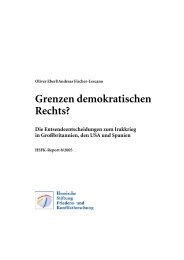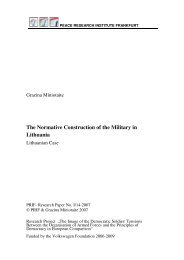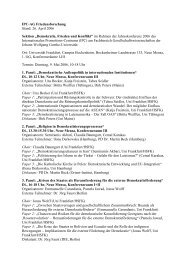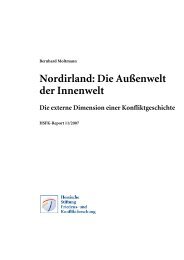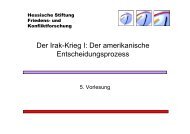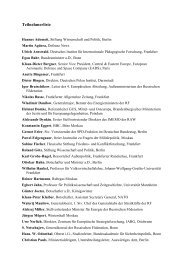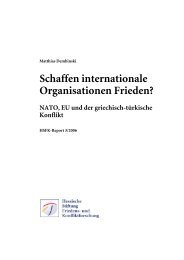From Exodus to Exitus Causes of post-war violence in El ... - eDoc
From Exodus to Exitus Causes of post-war violence in El ... - eDoc
From Exodus to Exitus Causes of post-war violence in El ... - eDoc
Create successful ePaper yourself
Turn your PDF publications into a flip-book with our unique Google optimized e-Paper software.
34 Heidrun Z<strong>in</strong>ecker<br />
this <strong>in</strong>terview, Jaime Rober<strong>to</strong> Vilanova, made the follow<strong>in</strong>g robust declaration <strong>to</strong> the author:<br />
“We consider human rights <strong>to</strong> be fundamental. There is no <strong>violence</strong> <strong>in</strong> the prisons”<br />
(Vilanova Chica 2006).<br />
All <strong>in</strong> all, <strong>in</strong> <strong>El</strong> Salvador’s <strong>post</strong>-<strong>war</strong> domestic security policy there has been a strategic<br />
transformation <strong>in</strong> favour <strong>of</strong> a more sophisticated strategy, better endowed with preventive<br />
and <strong>in</strong>tegrative elements, but on the whole nonetheless more repressive, which – as can be<br />
seen from the homicide rates – is not only unproductive, but counter-productive. The<br />
strategies have no relation at all <strong>to</strong> the causes <strong>of</strong> <strong>violence</strong>. There is no weakest l<strong>in</strong>k <strong>in</strong> the<br />
security sec<strong>to</strong>r, be it police, judiciary or penal system. Police and judiciary alike are characterized<br />
by a similar pendulum movement: transition <strong>to</strong> a more democratic regime<br />
(more pronounced <strong>in</strong> the police than <strong>in</strong> the judiciary) <strong>in</strong> the first five years follow<strong>in</strong>g the<br />
end <strong>of</strong> the <strong>war</strong>, followed <strong>in</strong> the case <strong>of</strong> both <strong>in</strong>stitutions by a turn <strong>to</strong><strong>war</strong>ds more repressive<br />
behaviour. A cont<strong>in</strong>u<strong>in</strong>g extremely high level <strong>of</strong> <strong>in</strong>efficiency (fail<strong>in</strong>g performance) on the<br />
part <strong>of</strong> these <strong>in</strong>stitutions is now accompanied by their highest level <strong>of</strong> repressive behaviour,<br />
imposed on them by correspond<strong>in</strong>g government strategies, and it can therefore not<br />
be balanced out by these. All three <strong>in</strong>stitutions listed above systematically violate the right<br />
<strong>to</strong> life, <strong>in</strong>creas<strong>in</strong>gly <strong>in</strong> a direct way, but also still <strong>in</strong> an <strong>in</strong>direct way, through failure <strong>to</strong> act.<br />
5. Conclusions<br />
In this report it has been empirically proven that <strong>in</strong> <strong>El</strong> Salvador with<strong>in</strong> the enabl<strong>in</strong>g and<br />
preventive structures for <strong>violence</strong>, which generally exist or are absent respectively <strong>in</strong> the<br />
extremely violent countries <strong>of</strong> Central America, and which manifest themselves here as<br />
rent economy and regime hybridity, there are two fac<strong>to</strong>rs <strong>in</strong> this form and comb<strong>in</strong>ation<br />
specific <strong>to</strong> this country, which cause the region’s highest level <strong>of</strong> <strong>violence</strong> here: these are<br />
on the one hand the extremely high rates <strong>of</strong> migration and remittances, and on the other<br />
the security sec<strong>to</strong>r characterized by its poor performance and repressive behaviour. As far<br />
as the rate <strong>of</strong> migration and remittances are concerned, by Central American standards<br />
these are at this level just as unique <strong>to</strong> <strong>El</strong> Salvador as the level <strong>of</strong> <strong>violence</strong>. At the same<br />
time they are constant as fac<strong>to</strong>rs, <strong>in</strong>asmuch as they are <strong>in</strong>creas<strong>in</strong>g steadily and cont<strong>in</strong>ually,<br />
i.e. without any jumps.<br />
The four questions raised <strong>in</strong> Chapter 2 can be answered as follows: while the extremely<br />
high rates <strong>of</strong> migration and remittances expla<strong>in</strong> the fundamentally high level <strong>of</strong> the <strong>post</strong><strong>war</strong><br />
rate <strong>of</strong> <strong>violence</strong> <strong>in</strong> <strong>El</strong> Salvador, the strategies and configurations <strong>of</strong> the security sec<strong>to</strong>r<br />
trigger the decisive fac<strong>to</strong>r <strong>in</strong> both the peaks and the trough <strong>of</strong> the homicide rate: its s<strong>in</strong>e<br />
curve reached its first peak when the security sec<strong>to</strong>r <strong>in</strong>stitutions were not yet operational.<br />
It sank <strong>in</strong><strong>to</strong> a trough when the new police force and judiciary were established, and these<br />
had achieved their highest level <strong>of</strong> democratic form <strong>to</strong> date, and when a newly implemented<br />
repressive security policy had not yet been able <strong>to</strong> unleash its devastat<strong>in</strong>g effect at<br />
this po<strong>in</strong>t. The second peak <strong>in</strong> the s<strong>in</strong>e curve corresponds with when further progress with<br />
performance <strong>in</strong> the security sec<strong>to</strong>r was not made, the democratic form dw<strong>in</strong>dled and repressive<br />
behaviour <strong>in</strong>creased.





